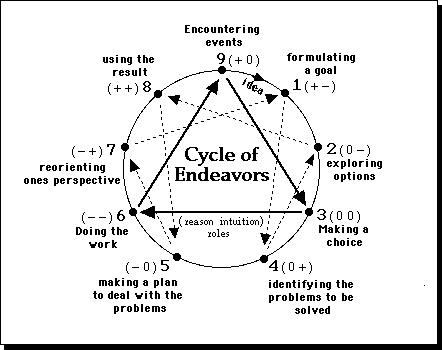Finally, a Model of Social Transformation
That Actually Explains
How & Why a Few Social Movements Succeed
While Most Fail
by Dan Shaw
About a month ago, I read Richard Moore's book, Escaping the Matrix. I'm not easily impressed by writers on such topics, having read quite widely on it for years. Still, the book inspired me, and I wrote a glowing review of it. Then, as luck would have it, I found my transatlantic airline ticket put me down in Dublin, Ireland, and passing through Richard's adopted hometown of Wexford. Fortunately, I had the time to spend a couple days with Richard, and eventually got around to asking him about the relationship between his political work and writings, and an illustration of a 9-pointed geometric shape on is bulletin board. It turns out that "Escaping the Matrix" owes its elegant structure to this 9-fold model of social transformation which Richard has been working with for some years.
 Some readers will recognize the circle of 9 points as it has been applied as a model of personality, "the Enneagram," but like all the best models, it applies equally well across disciplines; for example, scientific advances in optics with coherent light, lasers, led to similar progress in the field of audio and coherent sound. I had heard of this 9-fold Enneagram in the past, but Richard's new insights into its structure and application to social movements took it out of the realm of interesting theory and into the rational, practical application to social transformation. Richard's completely utilitarian and logical background in engineering and project development gave him a unique insight into using this 9-fold model, which I'll now describe in beginner's terms, no prior knowledge of the Enneagram is required to put it to use in your own political campaign.
Some readers will recognize the circle of 9 points as it has been applied as a model of personality, "the Enneagram," but like all the best models, it applies equally well across disciplines; for example, scientific advances in optics with coherent light, lasers, led to similar progress in the field of audio and coherent sound. I had heard of this 9-fold Enneagram in the past, but Richard's new insights into its structure and application to social movements took it out of the realm of interesting theory and into the rational, practical application to social transformation. Richard's completely utilitarian and logical background in engineering and project development gave him a unique insight into using this 9-fold model, which I'll now describe in beginner's terms, no prior knowledge of the Enneagram is required to put it to use in your own political campaign.
The only way to evaluate a model of any kind, is to test it by seeing how it works to explain the phenomenon you're endeavoring to understand. When a model like this one (which I'll call the "9-Stage Model") works, it's because the model, whatever model it is, is at once simple enough to give clarity, and complex enough to provide deeper insights. By the time you've read this brief article, you'll be able to apply the model to your own projects, political and otherwise, and see it work.

Richard used the 9-Stage Model to study the life-cycle of projects, and he found that it also applied to the structure of films and drama. After writing "Escaping the Matrix", he discovered that the 9-Stage Model parallels the structure of the book. Richard's unique background led him to his own discovery of the structure of the 9-Stage Model, and why the model works.
This info has not yet been published anywhere. Briefly, the 9-Stage Model shows the interaction of two forces, where each force has 3 possible "states": positive, negative, and neutral. Presumably this model would apply at all scales, from atoms and molecules, on up. The two forces combine in 9 different ways (3 squared=9).* In the illustration you see (+0), (+-), (0-), etc., where "0" = the neutral force. Endeavors, dramas, and social transformations proceed through each stage in a clockwise cycle to be successful; if stages are missed, the endeavor or social movement fails.

Take a moment now if you haven't already, and see if you find that this model makes sense of your own experience with social movements. As a trained mediator, I found the model made immediate sense to me. When two parties have a conflict, mediation provides an opportunity for the parties to harmonize and dialogue that is missing in the adversarial justice system of courts and judges, explaining why mediated settlements tend to endure, while judge's decisions are so often appealed.
Richard has published several articles on the 9-Stage Model ("Enneagram"), and obviously a full explanation, such as the meaning of the inner arrows, is beyond the scope of this article, and this reviewers ability.
"Escaping the Matrix" does not even mention the 9-Stage Model, but since its structure is the same, it is at this time the best book for further study and application of this model to social transformation and social movements. Many books have been written on the Enneagram and personality types, but none offers these deeper insights into essential stages in endeavors and the 3 states and 2 forces, those contributions are solely Richard's.
Further application and study of this model will show, for example, why any effective social movement must be "grassroots" and "from the ground up" and not the product of some opinion-making elites. "Escaping the Matrix" gives examples of social movements, such as the Populists, and why and how their movement worked (to the extent that it did).
I look forward to re-reading "Escaping the Matrix" with these new insights in mind, and I recommend it most highly to all political activists who are seeking insight, inspiration, and a renewal of energy and effectiveness.
*Compare the I-Ching, a model of three forces, each with two states, giving 2 cubed=8. All possible combinations of two such "tri-grams" gives 64 outcomes or qualities.

